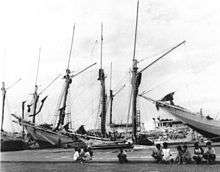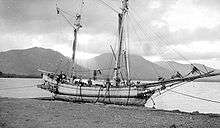Pinisi


The pinisi or phinisi is a traditional Indonesian two-masted sailing ship. It was mainly built by the Konjo tribe, a sub-ethnic group of Bugis-Makassar mostly residents at the Bulukumba regency of South Sulawesi but was, and still is used widely by the Buginese and Makassarese, mostly for inter-insular transportation, cargo and fishing purposes within Indonesian archipelago. UNESCO designated Pinisi boat-building art as Masterpiece of Oral and Intangible Heritage of Humanity at the 12th Session of the Unique Cultural Heritage Committee on Dec 7, 2017.[1] Pinisi is the largest Bugis traditional vessel after the disappearance of giant jong.[2]
General description
The hull of the ships looks similar to that of a dhow while the fore-and-aft rigging recalls western schooners, although it might be more correctly termed to resemble a ketch, as the front mast is the larger.
The large mainsails differ from western style gaff rigs though, as they often do not have a boom and the sail is not lowered with the gaff. Instead it is reefed towards the mast, much like a curtain, thus allowing the gaff to be used as deck crane in the harbour. The lower part of the mast itself may resemble a tripod or is made of two poles.
Pinisi may be 20 to 35 meters long and 350 tons in size. The masts may reach to 30 meters above the deck. In 2011 a large pinisi has been completed in Bulukumba, South Sulawesi. It is 50 m long and 9 m wide, the tonnage is about 500 tons.[3]
Types of pinisi
There are two general types of Pinisi.[4]
- Palari. Older type of Pinisi with a curved stern and keel. They were usually smaller than the Lamba and used 2 quarter rudder mounted at the side of the stern. Motorized version usually had single mechanized rudder behind its propeller, but majority of motorized vessel favored the lambo hull.
- Lamba or lambo. Pinisi of a long and slender built, having a straight stern. This type of Pinisi is the one currently surviving in its motorized version (PLM). Used single mechanized axial rudder, but some retained the quarter rudder for aesthetic purpose.
History
Traditional Buginese lontara manuscripts and stories document the use of pinisi by Buginese for transport, as a sailing boat, and as warship.
In the 19th century, Sulawesian sailor began to combine the traditional tanja rig with fore-and-aft rig from Western ships sailing through the archipelago. Pinisi evolved from the base hull of Padewakang with front-and-aft rig to its own hull model with a native "pinisi rig". During these evolutionary decades, Indonesian sailors and shipbuilders changed some features of the original western schooner. The first Sulawesian pinisi was thought to has been first built for the Biran captain by the Ara around 1900.
At first, schooner rig was applied to padewakang hull, but eventually the sailor used the faster palari hull instead. Almost the whole hull is cargo room, only a small cabin placed at the stern serve as captain's room, meanwhile the crew sleep on the deck or cargo room. The usage of double quarter rudder is retained.
Since the 1930s, this sailing ship adopted a new type of sail, the nade sail, which came from cutters and sloops used by Western pearl seekers and small traders in Eastern Indonesia. In the 1970s more pinisi were equipped with engines, which favored the use of lambo type hull. Because the sails only used as complement to the engine, the sails were removed, but some vessels retained its masts. These type of ships are called Perahu Layar Motor (PLM) - Motorized Sailing Vessel.
In the subsequent years the cargo capacity of pinisi increased to an average of 300 tons. Nade sails used on medium-sized ships, and the larger ships used pinisi rig. But because the masts became shorter due to installed engine as propulsion, the sails are only used in favorable winds.
Design and construction
Several parts of the pinisi are referred to by their original Buginese names, such as:
- Anjong, (balancing triangle) located at the front deck (Anjungan)
- Sombala, (main sail) the largest sail in the ship
- Tanpasere, (small sail) triangle-shaped sail, located at each mast
- Cocoro pantara (front additional sail).
- Cocoro tangnga (middle additional sail)
- Tarengke (row additional sail)
Modern use

Today, pinisi mainly used for trade, serves as inter-insular cargo, such as to transport timber from Kalimantan to Java, in exchange to transporting grocery and goods from industrialized Java to more remote ports in Indonesian archipelago. Pinisi often frequent traditional ports, such as Sunda Kelapa port in Jakarta, Surabaya, Banjarmasin, and the port of Makassar.
As with many traditional ship types, pinisi have been provided with motors, largely since 1970. This has changed the appearance of the ships. Comparable to modern dhows, the masts have been shortened, or omitted as deck cranes vanished completely, while structures on deck, usually aft, have been enlarged for the crew and passengers. In the early 1970s thousands of pinisi-palari ships measuring up to 200 tonnes of cargo, the world's largest commercial sailing fleet at the time, had contacted all corners of the Indian Ocean and became the trading backbone of the people.
The pinisi is modified into diving charter boat by foreigner investors for tourism purposes. One such example is that the boat is use as a pitstop for The Amazing Race.
See also
- Padewakang, predecessor of pinisi
- Tongkang
- Borobudur ship
- Schooner
- Pinas (ship)
References
- ↑ "UNESCO Acknowledges Pinisi as Intangible Cultural Heritage". Tempo. Retrieved 10 December 2017.
- ↑ Zainun, Nazarudin (2015). Antropologi Dan Sejarah Dalam Kearifan Tempatan. Penerbit USM.
- ↑ Sastrawat, Indra (22 November 2011). "Largest Pinisi Launched". Kompasiana. Retrieved 15 July 2018.
- ↑ Michael Kasten: The Indonesian Phinisi
Further reading
- G. Adrian Horridge, The Konjo boatbuilders and the Bugis Prahus of south Sulawesi, National Maritime Museum, London 1979.
- 2004 Horst H. Liebner, Malayologist, Expert Staff of the Agency for Marine and Fisheries Research, Department of Marine Affairs and Fisheries of the Republic of Indonesia
External links
| Wikimedia Commons has media related to Pinisi. |